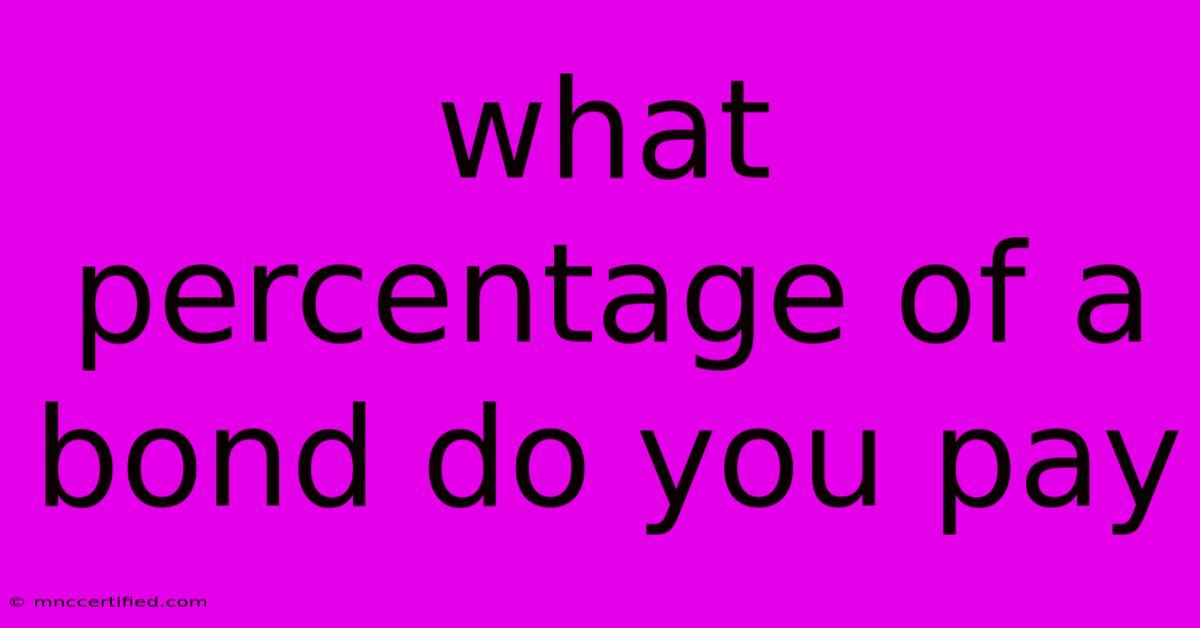What Percentage Of A Bond Do You Pay

Table of Contents
What Percentage of a Bond Do You Pay? Understanding Bond Pricing
When you invest in bonds, you're essentially loaning money to a government or corporation. In return, they promise to pay you back the principal amount (the original amount you invested) plus interest payments over a set period. But how much do you actually pay for a bond?
The Face Value vs. the Market Price
The face value of a bond, also known as the par value, is the amount you'll receive back when the bond matures. This is typically $1,000, though some bonds can have different face values.
However, the market price of a bond fluctuates daily based on factors like:
- Interest rates: When interest rates rise, the value of existing bonds falls, as investors can get a higher return on newly issued bonds.
- Creditworthiness: The financial health of the issuer affects the bond's price. A company or government with a lower credit rating will offer higher interest rates to compensate for the increased risk, leading to a lower market price.
- Time to maturity: The longer the time until a bond matures, the more sensitive its price is to interest rate changes.
What Percentage Do You Pay?
You don't pay a specific percentage of the bond's face value. Instead, you buy a bond at its current market price. This price can be:
- At par: The market price is equal to the face value.
- Above par: The market price is higher than the face value, also called a premium. This happens when the interest rate offered by the bond is higher than the prevailing market rate.
- Below par: The market price is lower than the face value, also called a discount. This happens when the interest rate offered by the bond is lower than the prevailing market rate.
Calculating the Actual Price
To understand the actual price you pay for a bond, you need to consider the yield and the coupon rate:
- Yield: The annual return you receive on your investment, taking into account the current market price and any accrued interest.
- Coupon rate: The fixed interest rate paid on the bond's face value.
The market price of a bond is determined by the relationship between its yield and its coupon rate. For example, if a bond has a coupon rate of 5% and the current market yield is 4%, the bond will trade at a premium. Conversely, if the market yield is 6%, the bond will trade at a discount.
Key Takeaways
- You don't pay a fixed percentage of a bond's face value.
- The market price of a bond is determined by its yield and coupon rate.
- Bonds can trade at par, above par (premium), or below par (discount).
- Understanding the relationship between yield and coupon rate is crucial for making informed investment decisions.
Further Research
To learn more about bonds and how they work, you can explore these resources:
- Investopedia:
- The Balance:
- U.S. Securities and Exchange Commission:
By understanding how bonds are priced and the factors that influence their market value, you can make more informed investment decisions and potentially achieve your financial goals.

Thank you for visiting our website wich cover about What Percentage Of A Bond Do You Pay. We hope the information provided has been useful to you. Feel free to contact us if you have any questions or need further assistance. See you next time and dont miss to bookmark.
Featured Posts
-
Messis Miami Falls Short Eliminated From Playoffs
Nov 11, 2024
-
Pakistan Wins 3rd Odi Against Australia
Nov 11, 2024
-
Dogecoin Price Jump 78 Rise Passes Xrp Usdc
Nov 11, 2024
-
Dogecoin Climbs 78 Outperforms Xrp Usdc
Nov 11, 2024
-
Tottenham Vs Ipswich Town Premier League Live
Nov 11, 2024